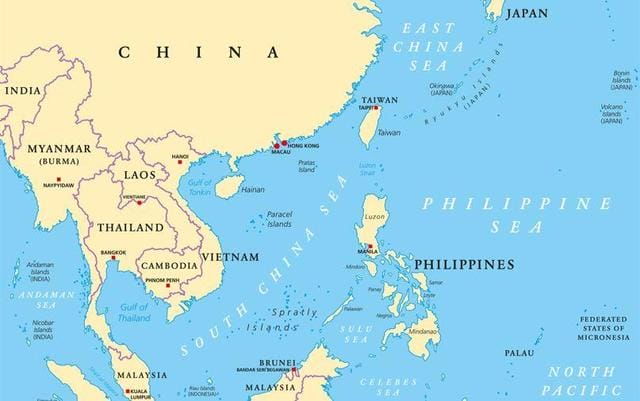By Collins Chong Yew Keat
Washington is upping the ante in deterring Beijing’s intent and actions in the region, especially in the South China Sea and in Taiwan.
Quad is now losing the momentum and is quite lethargic, and direct minilateral security mechanisms provide the needed boost in speeding up joint actions based on real shared threats.
The Camp David Pact last year underlines this move, and this is followed by the trilateral summit involving Manila and Tokyo.
The high level visits by Marcos Jr and Kishida to the White House and the clear joint statement in chastising Beijing for its destabilizing and threatening maneuvers in the South China Sea remain the clearest message ever that Washington has resilient and long lasting alliance options in the region in its containment efforts.
In defining the commitment to rules-based order and the intent to support Manila in case of any conflict in the region, and Tokyo’s own vow that Washington is not alone in defending the international law, all underscored the rising risk vulnerability of affected parties in the region.
Initiatives of joint patrols between Manila and Washington as agreed earlier will emphasize to China the extent and tightness of Philippine-U.S. alliance. It will enhance the Philippines’ leverage when China is deciding on its course of options.
Biden reiterated that any attack on Philippine assets in the South China Sea will involve the mutual defence treaty, and this provides new confidence for Manila in continuing its approach of publicly disclosing the physical reality of Beijing’s grey zone warfare and its continuous usage of its Coast Guard capacities in bullying Manila’s vessels. The Second Thomas Shoal became the domain of months of stand offs and confrontations ranging from laser incident to water cannoning of Manila’s vessels, which have been publicly highlighted by Manila in shining light on Beijing’s true extent of its actions.
Beijing condemns the joint statement and casts Washington as destabilizing the region with its so-called interference in the dispute and pinning regional players against it.
It now has the advantage of using this joint declaration and closer security partnership, alongside Tokyo’s unilateral move to edge closer with Manila through the Reciprocal Access Agreement and potentially joining Quad as the pretexts to double down on its aggressive approach in the South China Sea, homing in on the narrative that it is the Western led containment that has spiralled arms races and escalating security dilemma.
Beijing has continuously accused Manila of violating Chinese sovereignty, flipping the narrative equation and accusing the current Marcos Jr regime as kowtowing to Washington’s dictate and demand, in an apparent reference to the “gentleman’s agreement” made with the previous president, Rodrigo Duterte.
Duterte, a China leaning advocate, has failed to get an assured reciprocal assurance from Beijing on its security approach in the disputed zones, despite clear overtures and pivot.
Marcos Jr realized the costly mistake, and is now unwavering in his approach to defend the rules based order by courting an extended umbrella of support besides traditional ally in Washington.
Tokyo is seen as the safer bet, realizing the mutual security needs and concerns which will strengthen joint commitment in hard forces and long-lasting secondary support.
Kishida reiterated that “multi-layered cooperation is essential” and the trilateral meeting is a historic move. He is aware of the vulnerabilities of inaction, and the months of upswing in momentum in defence spending and modernisation and an array of new security and diplomatic overtures ranging from the the Official Security Assistance (OSA) to Reciprocal Access Agreement (RAA) with various regional partners reflect the urgency of Kishida in going beyond deterrence alone.
The volume of rejuvenation in the defence and security realm of Japan does not indicate that it is merely trying to bridge the gap in current defence capacities against Beijing’s military might and intent.
The end goal is always to prepare for a real time conflict and for war, whether it is from a Taiwan fallout or from the South China Sea tension.
It will need all the help that it can get, and to diversify the sources of alliances. Camp David is a good start, but Tokyo will need an expanded assurance.
Biden has asked Congress for an additional $128m for infrastructure projects at the Philippine bases, and sees Philippines as the cornerstone in stopping China at its near water boundary, preventing further dominance in the Pacific and Pacific Islands should a conflict start, reigniting its crucial roles during WWII.
Around $100bn in possible investment deals over the next five to 10 years reflects the two pronged message being sent to both Beijing and the region. To Beijing, it points to the growing economic and trade alternative in a credible and resilient manner that Washington is providing Manila and the region which can threaten the stranglehold of Beijing in its economic dependence trap and the vulnerability of the region to its economic coercion tools.
Japan needed a new fallback option, one that is easier and closer both geographically and in the domain of a physical country and neighbour that will have a sustained and more assured security support and other assistance during a real time conflict.
Manila remains the most strategic and vital player in this regard, as it will provide the necessary secondary front for Japan’s potential conflict with China, whether it is from a Taiwan fallout or from the larger implication of South China Sea conflict.
The RAA with Manila provides a mutual benefit structure to both parties, as Tokyo will stand to gain from an expanded presence in its southern flank, which will also complement the existing US presence and base in Okinawa. Manila’s existing American presence and the extended bases will be the perfect platform for Tokyo’s intent to have a more secured extended power projection beyond its near border.
Manila is thus seen as a safer bet for Tokyo to have a nearer presence and power projection near the South China Sea, serving for a more strategic and a nearer presence to the strategic and vital Luzon Strait, the entrance to South China Sea.
The RAA is meant to be seen as a message to regional players that Japan is ready to go beyond the traditional methods of OSA and ODA in engaging the region, and that it is ready to go deeper in a more direct overture in having a physical presence in a way that is mutually beneficial.
It is also meant to send a message to Beijing that Tokyo is not confined to direct physical confrontation with Beijing in the case of a conflict, but it will have a legally sustained support system that will be resilient and long lasting, and that the RAA will also create a ripple effect on other regional players who might see the benefits and impact and follow suit.
China invested in a gigantic push for port building through its decade-old Belt and Road Initiative, but it remains difficult to determine which ones will be strategically used for hard power projection tools. Ream port in Cambodia is an obvious intent, showcasing Beijing’s naval statecraft and how the West is scrambling to match the audacity of Beijing’s full fledged naval and hard power intent.
Beijing is more interested now in geopolitical advantage, especially in terms of operations.
The future of regional stability and the rules based order is getting more uncertain with the unwavering intent of the West in defending these, and with the equal intent by Beijing in doubling down on its approach.
The West, lacking geographical advantage with the sheer distance and distractions in the Middle East and Ukraine, makes it up with and ever more robust, credible and trust based current and future alliance potential with existing and future allies that are in jitters with Beijing’s current and future muscle flexing and double down of power moves in the region.
The author is a Foreign Affairs, Strategy and Security Analyst at Universiti Malaya









